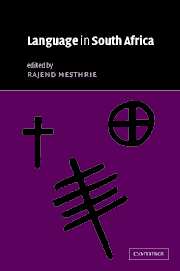Book contents
- Frontmatter
- Contents
- List of maps
- List of contributors
- Acknowledgements
- List of phonetic symbols
- List of abbreviations
- Introduction
- Part I The main language groupings
- Part II Language contact
- 9 Fanakalo: a pidgin in South Africa
- 10 Mutual lexical borrowings among some languages of southern Africa: Xhosa, Afrikaans and English
- 11 Code-switching, mixing and convergence in Cape Town
- 12 Code-switching in South African townships
- 13 Intercultural miscommunication in South Africa
- 14 Women's language of respect: isihlonipho sabafazi
- 15 The sociohistory of clicks in Southern Bantu
- 16 The political economy of language shift: language and gendered ethnicity in a Thonga community
- 17 From second language to first language: Indian South African English
- 18 Black South African English
- 19 The lexicon and sociolinguistic codes of the working-class Afrikaans-speaking Cape Peninsula coloured community
- 20 An Introduction to Flaaitaal (or Tsotsitaal)
- 21 Language and language practices in Soweto
- Part III Language planning, policy and education
- Index
- References
10 - Mutual lexical borrowings among some languages of southern Africa: Xhosa, Afrikaans and English
from Part II - Language contact
Published online by Cambridge University Press: 22 September 2009
- Frontmatter
- Contents
- List of maps
- List of contributors
- Acknowledgements
- List of phonetic symbols
- List of abbreviations
- Introduction
- Part I The main language groupings
- Part II Language contact
- 9 Fanakalo: a pidgin in South Africa
- 10 Mutual lexical borrowings among some languages of southern Africa: Xhosa, Afrikaans and English
- 11 Code-switching, mixing and convergence in Cape Town
- 12 Code-switching in South African townships
- 13 Intercultural miscommunication in South Africa
- 14 Women's language of respect: isihlonipho sabafazi
- 15 The sociohistory of clicks in Southern Bantu
- 16 The political economy of language shift: language and gendered ethnicity in a Thonga community
- 17 From second language to first language: Indian South African English
- 18 Black South African English
- 19 The lexicon and sociolinguistic codes of the working-class Afrikaans-speaking Cape Peninsula coloured community
- 20 An Introduction to Flaaitaal (or Tsotsitaal)
- 21 Language and language practices in Soweto
- Part III Language planning, policy and education
- Index
- References
Summary
INTRODUCTION
This chapter is an exploratory piece, which will focus where possible on the motives for lexical borrowing and on the lexical fields in which borrowings take place. It will not discuss the effects of borrowing on linguistic form. Xhosa, English and Afrikaans have been chosen because the authors, between them, have some working acquaintance with all three, and because they are major languages of southern Africa with contrasting social histories.
Our point of departure will be the classical paper of Haugen (1972 [1950]) on borrowing. Although Haugen is pleasantly clear on what borrowing is, we shall take the liberty of offering a definition based on his, but somewhat different in wording: ‘the adoption into one language of items, patterns and meanings from another’. Here the term ‘adoption’, which we owe to Desmond Cole, is important to distinguish between nonce-words, borrowed ad hoc, as in ‘ons moet daardie fridge nou laai’ (we must now load that fridge), and words established in a language, as commandeer (from French via Afrikaans) is now established in English. Whether a word is really established or not can be decided only on the basis of a respectable body of evidence of use, as in the collections of actual contexts that form the data base for every entry in the Oxford English Dictionary or the Dictionary of South African English on Historical Principles (DSAE Hist). Most of us, however, make this judgement impressionistically and without data, other than those of daily experience.
- Type
- Chapter
- Information
- Language in South Africa , pp. 199 - 215Publisher: Cambridge University PressPrint publication year: 2002
References
- 11
- Cited by

